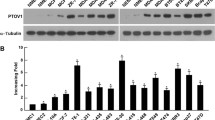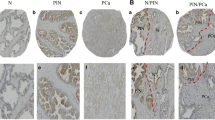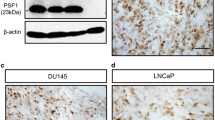Abstract
Background
To investigate the prognostic value of expression levels of nin one binding protein (Nob1) in prostate carcinoma.
Methods
Nob1 protein levels were evaluated by Western blot in samples from 40 prostate carcinomas and matched adjacent non-neoplastic prostate tissues. Nob1 expression was also assessed by immunohistochemistry in samples from 300 prostate carcinoma and matched adjacent non-neoplastic prostate tissues, as well as 20 benign prostatic hyperplasia samples. The findings were compared with clinical and pathologic parameters and patient outcome.
Results
Nob1 protein analysis showed significant differences between the prostate carcinomas and control groups tested. Immunohistochemical analysis showed that Nob1 positivity was higher in prostate carcinoma than that in paired adjacent non-cancerous tissues (58 vs 7 %, P < 0.001). Nob1 positivity was significantly associated with high Gleason scores and metastasis in patients. Nob1 expression was significantly associated with shorter biochemical recurrence-free survival (BCRFS). Multivariate analysis revealed that Nob1 is an independent marker for BCRFS.
Conclusions
These findings provide evidence that Nob1 is an indicator of poor prognosis in prostate carcinoma.



Similar content being viewed by others
References
Rebbeck TR, Devesa SS, Chang BL, Bunker CH, Cheng I, Cooney K, et al. Global patterns of prostate cancer incidence, aggressiveness, and mortality in men of African descent. Prostate Cancer. 2013;2013:560857.
Zaorsky NG, Raj GV, Trabulsi EJ, Lin J, Den RB. The dilemma of a rising prostate-specific antigen level after local therapy: what are our options? Semin Oncol. 2013;40:322–36.
Havre PA, Abe M, Urasaki Y, Ohnuma K, Morimoto C, Dang NH. The role of CD26/dipeptidyl peptidase IV in cancer. Front Biosci. 2008;13:1634–45.
Cary KC, Cooperberg MR. Biomarkers in prostate cancer surveillance and screening: past, present, and future. Ther Adv Urol. 2013;5:318–29.
Zhang Y, Ni J, Zhou G, Yuan J, Ren W, Shan Y, Tang W, Yu L, Zhao S. Cloning, expression and characterization of the human NOB1 gene. Mol Biol Rep. 2005;32:185–9.
Hong L, Piao Y, Han Y, Wang J, Zhang X, Du Y, et al. Zinc ribbon domain-containing 1 (ZNRD1) mediates multidrug resistance of leukemia cells through regulation of P-glycoprotein and Bcl-2. Mol Cancer Ther. 2005;4:1936–42.
Granneman S, Nandineni MR, Baserga SJ. The putative NTPase Fap7 mediates cytoplasmic 20S pre-rRNA processing through a direct interaction with Rps14. Mol Cell Biol. 2005;25:10352–64.
Lin Y, Peng S, Yu H, Teng H, Cui M. RNAi-mediated downregulation of NOB1 suppresses the growth and colony-formation ability of human ovarian cancer cells. Med Oncol. 2012;29:311–7.
Ghadersohi A, Sharma S, Zhang S, Azrak RG, Wilding GE, Manjili MH, et al. Prostate-derived Ets transcription factor (PDEF) is a potential prognostic marker in patients with prostate cancer. Prostate. 2011;71:1178–88.
Xie C, Kim HJ, Haw JG, Kalbasi A, Gardner BK, Li G, et al. A novel multiplex assay combining autoantibodies plus PSA has potential implications for classification of prostate cancer from non-malignant cases. J Transl Med. 2011;9:43.
Li XY, Luo QF, Li J, Wei CK, Kong XJ, Zhang JF, et al. Clinical significance of NOB1 expression in breast infiltrating ductal carcinoma. Int J Clin Exp Pathol. 2013;6:2137–44.
Kluge R, Giesen K, Bahrenberg G, Plum L, Ortlepp JR, Joost HG. Quantitative trait loci for obesity and insulin resistance (Nob1, Nob2) and their interaction with the leptin receptor allele (LeprA720T/T1044I) in New Zealand obese mice. Diabetologia. 2000;43:1565–72.
Che JP, Li W, Yan Y, Liu M, Wang GC, Li QY, Yang B, Yao XD, Zheng JH. Expression and clinical significance of the nin one binding protein and p38 MAPK in prostate carcinoma. Int J Clin Exp Pathol. 2013;6:2300–11.
Acknowledgments
This study was supported by the National Natural Science Foundation of China (81202036) and the Postdoctoral Funds of China (2013M532143 and 2013M542435).
Conflict of interest
None.
Author information
Authors and Affiliations
Corresponding author
Additional information
G. Liu, D. Shen and L. Jiao contributed equally to this study.
Rights and permissions
About this article
Cite this article
Liu, G., Shen, D., Jiao, L. et al. Nin one binding protein expression as a prognostic marker in prostate carcinoma. Clin Transl Oncol 16, 843–847 (2014). https://doi.org/10.1007/s12094-014-1158-x
Received:
Accepted:
Published:
Issue Date:
DOI: https://doi.org/10.1007/s12094-014-1158-x




